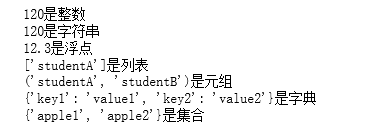python类型判断_python中判断变量的类型
python的数据类型有:数字(int)、浮点(float)、字符串(str),列表(list)、元组(tuple)、字典(dict)、集合(set)
一般通过以下方法进行判断:
1、isinstance(参数1,参数2)
描述:该函数用来判断一个变量(参数1)是否是已知的变量类型(参数2) 类似于type()
参数1:变量
参数2:可以是直接或间接类名、基本类型或者由它们组成的元组。
返回值: 如果对象的类型与参数二的类型(classinfo)相同则返回 True,否则返回 False
例子:
1 #判断变量类型的函数
2 deftypeof(variate):3 type=None4 ifisinstance(variate,int):5 type = "int"
6 elifisinstance(variate,str):7 type = "str"
8 elifisinstance(variate,float):9 type = "float"
10 elifisinstance(variate,list):11 type = "list"
12 elifisinstance(variate,tuple):13 type = "tuple"
14 elifisinstance(variate,dict):15 type = "dict"
16 elifisinstance(variate,set):17 type = "set"
18 returntype19 #返回变量类型
20 defgetType(variate):21 arr = {"int":"整数","float":"浮点","str":"字符串","list":"列表","tuple":"元组","dict":"字典","set":"集合"}22 vartype =typeof(variate)23 if not (vartype inarr):24 return "未知类型"
25 returnarr[vartype]26
27 #判断变量是否为整数
28 money=120
29 print("{0}是{1}".format(money,getType(money)))30 #判断变量是否为字符串
31 money="120"
32 print("{0}是{1}".format(money,getType(money)))33 money=12.3
34 print("{0}是{1}".format(money,getType(money)))35 #判断变量是否为列表
36 students=['studentA']37 print("{0}是{1}".format(students,getType(students)))38 #判断变量是否为元组
39 students=('studentA','studentB')40 print("{0}是{1}".format(students,getType(students)))41 #判断变量是否为字典
42 dictory={"key1":"value1","key2":"value2"}43 print("{0}是{1}".format(dictory,getType(dictory)))44 #判断变量是否为集合
45 apple={"apple1","apple2"}
46 print("{0}是{1}".format(apple,getType(apple)))
返回:
2、通过与已知类型的常量进行比较
例子:
1 #判断变量类型的函数
2 deftypeof(variate):3 type1 = ""
4 if type(variate) == type(1):5 type1 = "int"
6 elif type(variate) == type("str"):7 type1 = "str"
8 elif type(variate) == type(12.3):9 type1 = "float"
10 elif type(variate) == type([1]):11 type1 = "list"
12 elif type(variate) ==type(()):13 type1 = "tuple"
14 elif type(variate) == type({"key1":"123"}):15 type1 = "dict"
16 elif type(variate) == type({"key1"}):17 type1 = "set"
18 returntype119 #返回变量类型
20 defgetType(variate):21 arr = {"int":"整数","float":"浮点","str":"字符串","list":"列表","tuple":"元组","dict":"字典","set":"集合"}22 vartype =typeof(variate)23 if not (vartype inarr):24 return "未知类型"
25 returnarr[vartype]26
27 #判断变量是否为整数
28 money=120
29 print("{0}是{1}".format(money,getType(money)))30 #判断变量是否为字符串
31 money="120"
32 print("{0}是{1}".format(money,getType(money)))33 money=12.3
34 print("{0}是{1}".format(money,getType(money)))35 #判断变量是否为列表
36 students=['studentA']37 print("{0}是{1}".format(students,getType(students)))38 #判断变量是否为元组
39 students=('studentA','studentB')40 print("{0}是{1}".format(students,getType(students)))41 #判断变量是否为字典
42 dictory={"key1":"value1","key2":"value2"}43 print("{0}是{1}".format(dictory,getType(dictory)))44 #判断变量是否为集合
45 apple={"apple1","apple2"}46 print("{0}是{1}".format(apple,getType(apple)))
返回:
补充:
isinstance() 与 type() 区别:
type() 不会认为子类是一种父类类型,不考虑继承关系。
isinstance() 会认为子类是一种父类类型,考虑继承关系。
如果要判断两个类型是否相同推荐使用 isinstance()。
